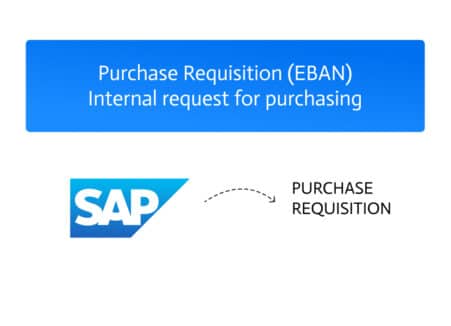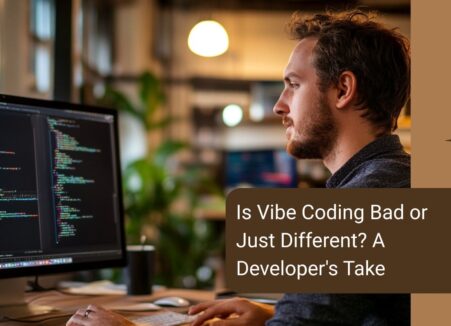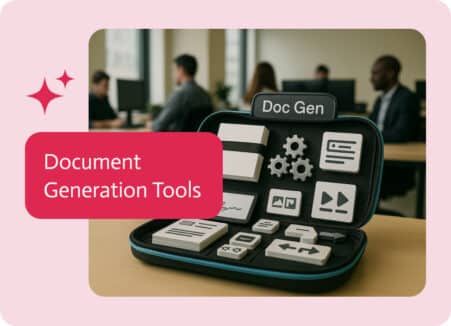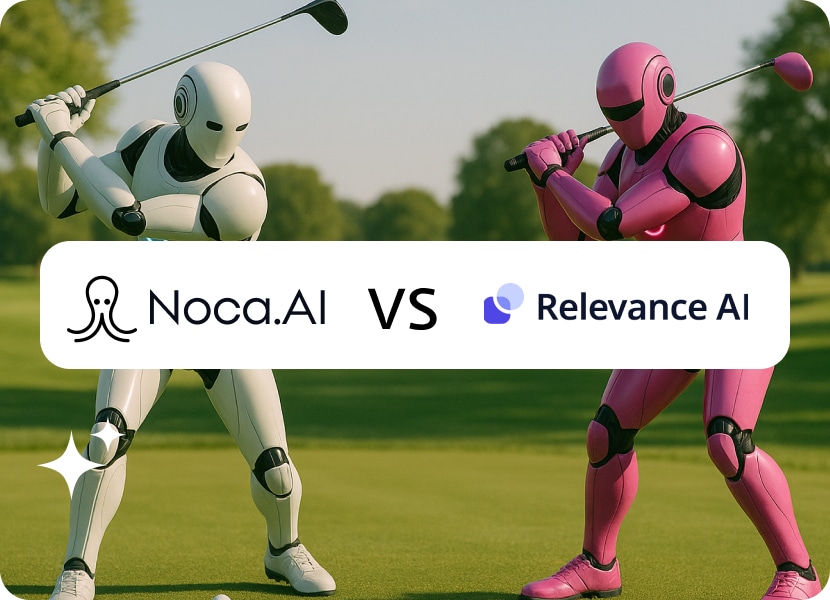
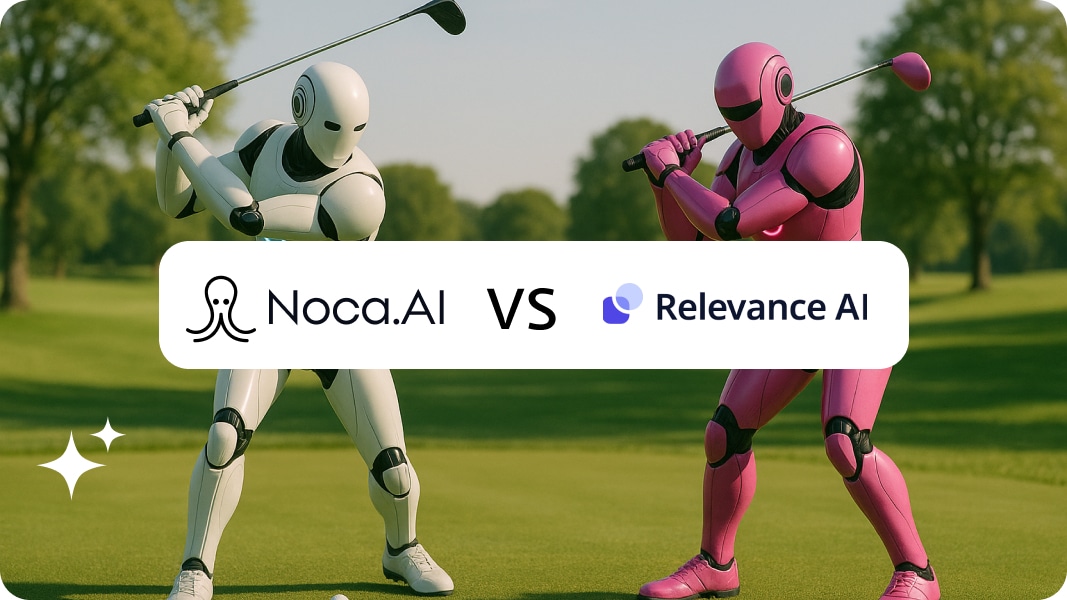
Noca vs. Relevance AI: Comparing Digital Employee Platforms
The world is going through some wild changes, and more so in the AI sector than anywhere else. According to recent stats, the advancement of technology in general has already surpassed where we thought it would be, according to Moore’s law. The industry has seen an increase of nearly 322%, and there’s no evidence of it slowing down. So you’d better get ready, because 2025 has seen the rise of the digital employee, and we’re here to see who rules the roost in this Noca vs. Relevance AI comparison.
Welcome to the age of AI workforce platforms, where the question isn’t whether you should automate with intelligent agents, but which platform will help you do it best. Two names keep dominating the conversation: Relevance AI and Noca. Both promise to make complex business processes completely automated and managed by AI workers that actually get stuff done. But which one should you choose?
What’s the Deal with Digital Employees?
Before we pit these platforms against each other, we need to establish what we’re actually talking about. Digital employees aren’t your grandfather’s automation scripts, and they’re certainly not just IF-THIS-THEN-THAT macros with a fancy name slapped on them.
Modern digital employees are end-to-end, autonomous employees that are capable of logging into systems, reasoning through workflows, talking to customers, negotiating steps, and confirming completion. They don’t just help with work, they’re here to actually do most of the work for you.
These modern AI-powered digital employees handle entire business processes: qualifying leads, processing loan applications, managing customer onboarding, or coordinating between all your other systems. So what’s the difference between these and traditional automation? Intelligence, adaptability, and decision-making ability based on context instead of standard rules and constructs from yesteryear.
Meet the Contenders: Noca vs. Relevance AI
Relevance AI burst onto the scene as the darling of Australia’s AI startup, raising $10M in Series A funding and seeing a 40x increase in agents created year-over-year, with 40,000 agents created in January 2025 alone. They’ve positioned themselves as “the home of the AI workforce,” offering a low-code platform where anyone can supposedly build teams of digital employees.
Noca, meanwhile, has been making progress with a slightly different approach. Rather than just being an agent builder, Noca is an AI agents builder with a fast track for creating and deploying digital employees, featuring bi-directional integrations with just about any enterprise system. It’s not merely about building agents, it’s about making agents that effortlessly integrate with the systems you already use.
The Building Experience: Noca vs. Relevance AI.
This is where it gets interesting. One claims to be low-code while the other is no-code, but what does that really mean when you have to get something done fast?
Relevance AI’s Approach
Relevance AI has a drag-and-drop builder where you can connect different models, use data from different places, and set up actions to create custom processes. They have a library of over 100 templates for things like researching leads, writing blog posts, and performing data analysis on markets.
The platform shines when you’re building multi-agent systems. You can have one agent that researches a topic, a second that drafts content that is centered around research, and a third that distributes it via email, all collaborating as a single digital team. It’s genuinely clever, but only when it works.
But here’s the catch: users consistently report that building with Relevance AI took approximately 45 minutes for a simple workflow, required building two agents, configuring credit usage thresholds, and testing webhook handoffs. There’s flexibility, sure, but this flexibility will more than likely come with a certain level of unwanted complexity
Noca’s Philosophy
Noca took a totally different path by making sure you didn’t have to design everything. Noca lets you describe what your business needs, then it understands and instantly delivers the right solution, whether it’s an app, an automation, or your very own digital employee.
Here’s what that looks like in practice: You describe your app in plain English, and AI instantly builds the interface, rationale, and even the links. You can tweak it at any time with simple, conversational prompts. Need an employee feedback tracker? Just describe it. Want to build a custom access management tool? Tell Noca what you want. Noca uses NLP to comprehend what you want and builds from there.
The result? Businesses typically see results from this approach in just weeks, with faster development, fewer errors, and streamlined delivery, which automatically leads to substantial ROI almost immediately.
The Integration Reality Check of Noca vs. Relevance AI
Ok, so in theory it seems legit, but how does it stand up in practice, where many AI agent platforms fall flat on their faces? You can build the world’s most impressive digital employee. But if it can’t talk to your Salesforce, pull data from your ERP, or update your warehouse management system, let’s be transparent about it: you’ve basically got yourself a very expensive prompt to chat bot.
Relevance AI’s Integration
Relevance AI integrates with most major business tools like Salesforce, which does kind of help incorporate AI automation without changing their current processes. They offer API and webhook capabilities, which are solid in most cases.
However, setting up the integrations can be technical. Common problems include navigating APIs and credit-based pricing, with users noting that customizing specialized cases can get a bit tricky. If your stack is straightforward, like a CRM here and a marketing platform there, you’ll probably be fine. But as soon as you start scaling up to enterprise levels with legacy systems? That’s when things start to get a little more spicy.
Noca’s Enterprise Integration Worth
This is when Noca flexes its muscles, because the platform was built with enterprise integration as a core feature, not a mere afterthought. Noca offers bidirectional integrations with CRMs, ERPs, or basically any enterprise system, and ensures that every app follows the TRAPS framework, delivering enterprise-grade compliance out of the box.
Noca connects over 500 applications and services like ERP, CRM, marketing tools, e-commerce platforms, and more with AI Agent Orchestration that deploys digital employees, automating processes spanning various systems, monitoring data, and carrying out proactive measures autonomously.
AI Intelligence Layer: Noca vs. Relevance AI
Both Noca and Relevance AI utilize LLMs, but they do so in slightly different ways, and those differences matter when your digital employee is making actual business decisions that determine whether you’re going to be in the red next quarter.
Relevance AI’s AI Capabilities
Relevance AI offers you flexibility with customizable assistants that comprehend user input, learn from data, and carry out tasks automatically by supporting multiple LLM providers. The platform provides AI-powered tools for analysis, info retrieval, and basic task automation.
Their digital employees are built to be specialists. Take Bosh, their AI sales agent: Bosh reviews revenue info, identifies trends, provides actionable insights, identifies desirable profiles, determines best outreach channels, and automates personalized messages.
Noca’s Contextual Intelligence
Noca’s AI isn’t just about doing tasks. It’s about understanding the situation across your business. Noca AI empowers digital employees with the ability to absorb information, evolve, and respond dynamically. So by processing the new data, they’re recognizing changing business conditions and intelligently adjusting workflows.
Here’s what sets it apart: Noca AI enables context-aware decision-making by letting AI agents read data from any system, analyze real-time insights, and make intelligent choices. Your agent isn’t just going by a script; it’s making decisions based on what’s actually happening across your integrated systems.
Noca also goes beyond simple reactions by optimizing processes, identifying inefficiencies, recommending next best actions, and enabling digital employees to be proactive. It’s the difference between an employee who waits to be told what to do and one who sees a problem coming and fixes it before you even know it exists.
Noca vs. Relevance AI: Collaboration and Team Workflows
Building complete digital employees that are continuously optimized is rarely a one-person job. These projects need input from business analysts, subject matter experts, IT teams, and executives who definitely don’t code.
Relevance AI’s Collaboration
Relevance AI allows you to build teams of digital employees that work together. The platform gives businesses a chance to build teams of agents that are able to work autonomously or collaboratively, which is powerful for organizations thinking in terms of distributed AI workforces.
However, the human collaboration side, getting your actual team to build these agents together, can be more challenging. The technical nature of the platform means you often need someone technical to shepherd the process.
Noca’s Built-for-Teams Approach
Noca invites teammates to co-design, comment, and iterate together in one shared environment, accelerating the development and design process. This isn’t just version control; it’s true collaboration where business users and technical users work side-by-side.
The natural language interface means that a marketing can describe what they need, a developer can review the tech aspect if needed, and a compliance officer can verify the security, all without context-switching between tools or translating between business and technical languages.
Real-World Performance and Reliability
Pretty demos are great until Monday morning when your digital employee needs to process 10,000 customer requests without breaking a sweat.
Relevance in Production
Relevance AI is boosting productivity for thousands of subject-matter experts at fast-growing scaleups to Fortune 500 companies, including Qualified, Activision, and SafetyCulture. Their agents handle real work at scale.
It’s noted that performance can vary depending on what exactly it is that you’re doing. Relevance AI’s agent system is solid, but setup is heavier, and LLM usage burns credits, which means that you’re going to be carefully watching your credit usage. Production deployments need careful resource planning, especially if you want to make sure that you’re not inadvertently running over budget or about to suffer from performance issues.
Noca’s Enterprise Reliability
Noca features auto-scaling, performance tuning, and fault tolerance built in, so your app stays fast and reliable as usage grows. This isn’t accidental, it’s by architectural design.
Noca provides full visibility and control through an intuitive interface to track every process, monitor flow health, and remedy any issues with ease, with real-time adaptation so digital employees can adjust workflows live, which means your integrations keep up with real-time changes.
Noca vs. Relevance AI: Security & Compliance
This certainly isn’t sexy, but ignore it at your peril. Your digital employees will be able to access confidential info, make financial calls, and obviously interact with your hard-earned customers. One security breach or compliance failure, and that could torpedo your entire AI initiative.
Relevance AI’s Security Posture
Relevance AI is certified as SOC 2 Type II and aligns with regulations, offering information storage solutions depending on where you are. That’s solid, especially the regional options for companies that have to follow data rules.
Noca’s Enterprise-Grade Framework
Every app follows Noca’s TRAPS framework: Trusted, Responsible, Auditable, Private, and Secure, delivering enterprise-grade compliance out of the box. This isn’t optional add-on security; it’s baked into every digital employee from the get-go.
In addition, Noca AI follows strict protocols, like encryption, role-based access, and auditing, compliant with major global standards.
Noca vs. Relevance AI Pricing
Let’s talk about the money aspect, because the best platform is the one you can actually afford to use at scale.
Relevance AI’s Pricing
Relevance AI offers a free tier with 100 credits a day, 1 user, and 10MB of knowledge storage. The Pro plan is $19/month with 10,000 credits and 2,500 runs per month. The Team plan is $199/month with 100,000 credits and 33,333 monthly runs.
The credit system is both a strength and a weakness. It provides flexibility, but it’s easy to underestimate credit burn with agents that call external APIs or process large datasets. Budgeting becomes tricky when usage patterns vary.
Noca’s Value Model
Whether you’re just starting out or relying on it to power your entire business, Noca ahs something tailored to meet your needs.
The are four packages on offer at Noca. The free tier is perfect for anyone that just wants to test the waters and see what’s under the hood. A starter tier at $20, great for individuals, a growth tier at $50 for those looking to streamline operations, and finally, the scale tier designed for large enterprises.
Noca’s model delivers measurable ROI almost immediately, with businesses seeing results in just weeks through faster development, fewer errors, and streamlined delivery.
Because Noca eliminates the outdated, manual processes when it comes to connecting enterprise systems, no longer do you need to invest months into building integrations or hire expensive consultants. That’s where the real ROI lives, not just in subscription costs, but in implementation time and maintenance.
Deployment Reality
Theory is lovely, but let’s talk about what actually happens when you try to get them into production.
A test comparing setup times found that Relevance AI took approximately 45 minutes for a simple workflow building two agents, while similar workflows on other platforms took just 10 minutes using prebuilt templates. That delta multiplies across your organization. Ten agents? That’s hours. A hundred? That’s days or weeks.
Noca’s approach of describing what you need and having the AI build it dramatically accelerates this timeline. The platform learns from previous data and usage patterns, refining suggestions in real time, with the ability to link any service, API, and database by simply telling the AI, no setup or connectors needed.
The Verdict: Noca vs. Relevance AI, Who Wins?
Here’s the uncomfortable truth: this isn’t a fair fight, because they are solving different problems for different customers.
For small to mid-sized businesses with standard tech stacks and technical resources, Relevance AI offers a flexible, agent-focused platform that’s growing fast and backed by customers.
But for enterprises, or anyone else for that matter with complex integration needs, or the need for digital employees to be integrated into mission-critical workflows with enterprise-grade security, Noca’s architecture, integration depth, and compliance make it the more strategic choice.
The Future of Digital Workforces
By the end of 2025, almost every company will have a team of digital employees, which will enable human teams to be limited by only their ideas, not their size. This transformation is happening now, not in some distant future.
The question is which platform will help you build it fastest, most reliably, and with the deepest integration into your current business systems.
Relevance AI brings innovation, flexibility, and a growing community of users and templates. Noca brings enterprise-grade infrastructure, integration abilities next to none, and a platform designed for business users from day one, enabling AI app generation that turns ideas into fully functional applications in minutes.
